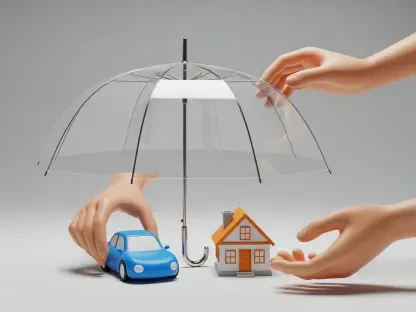The landscape of homeowners insurance in the United States is undergoing a significant transformation as skyrocketing premiums leave millions of homes uninsured. In recent years, the affordability crisis in the insurance sector has worsened, impacting households across economic and ethnic spectrums. This coverage gap exposes property owners to heightened risks, particularly in regions prone to climate-related disasters. The Federal Reserve’s most recent report reveals a concerning rise in the number of uninsured homeowners, highlighting a critical economic issue that demands urgent attention. In parallel, experts and organizations are pointing to broader economic and policy implications, calling for innovative solutions to address this growing predicament.
Economic Strain on American Homeowners
Inflation and Income Disparities Worsen Situation
The connection between escalating insurance premiums and economic challenges for American homeowners cannot be ignored. Insurance costs have surged to represent over 20% of the average mortgage payment, a dramatic rise from previous decades. For families already affected by inflation and income stagnation, this increase imposes a substantial financial burden. Particularly hard-hit are households with annual earnings under $25,000, where the potential loss of insurance coverage represents an untenable risk. Notably, this economic strain disproportionately affects Native American, Hispanic, and Black homeowners, exacerbating existing inequalities in homeownership and financial security. These dynamics are mirrored by socioeconomic pressures, where communities with historically lower incomes face mounting barriers to maintaining adequate home protection. The result is not just a personal crisis for individual homeowners but also a broader economic challenge impacting neighborhood stability.
The Impact on Housing and Community Stability
The economic repercussions of unaffordable insurance extend beyond individual households, affecting entire communities and local economies. As premiums increase, foreclosures become more frequent, resulting in a rise in abandoned properties which strain local services and reduce municipal revenues. Without insurance, many homeowners find themselves in precarious situations, unable to recover from damage incurred through natural disasters or unexpected accidents. This absence of a financial safety net contributes to a downward spiral in property values, further destabilizing affected neighborhoods. These challenges underscore the interconnected nature of housing market health, highlighting the essential role of insurance in maintaining community well-being. The potential long-term consequences of these trends necessitate comprehensive policy interventions.
Policy and Industry Responses
Recommendations from Industry Experts
In response to the growing crisis, industry experts and consumer advocacy groups are proposing solutions to mitigate the impact of rising insurance costs. Recommendations include mandatory transparency in insurance pricing and underwriting, designed to foster greater accountability and competition among providers. Enhancing incentives for homeowners to adopt climate-resilient home modifications could also significantly reduce risk and, by extension, insurance costs. Policymakers are urged to consider regulatory changes that address systemic inequalities and promote affordable insurance access nationwide. These proposed measures aim to balance consumer protection with industry viability, creating a more sustainable ecosystem for homeowners insurance. By addressing these challenges head-on, experts hope to stem the tide of uninsured homes and restore confidence in the insurance market.
Collaborative Efforts for Sustainable Solutions
The path forward requires collaborative efforts from government agencies, insurance companies, and community organizations to tackle this complex issue. Implementing effective policies will depend on a coordinated approach that addresses the root causes of unaffordable insurance. Programs encouraging preventative measures and risk reduction, such as subsidies for resilient building materials or technology, offer viable pathways to cost-effective solutions. Joint initiatives between the public and private sectors will be crucial in pioneering innovative insurance models that cater to diverse community needs. By leveraging shared resources and expertise, these collaborations aim to build a more equitable and resilient insurance landscape. A forward-thinking strategy will be vital to ensuring all homeowners can gain access to fair and comprehensive coverage.
Navigating Future Challenges and Opportunities
The landscape of homeowners insurance in the U.S. is facing considerable shifts as premiums soar, leaving millions uninsured. This affordability crisis in the insurance domain has intensified recently, affecting diverse households across economic and ethnic lines. This coverage void heightens risks for property owners, especially in areas vulnerable to climate-linked disasters. The Federal Reserve’s latest reports reveal a troubling increase in uninsured homeowners, underscoring a pressing economic issue that requires immediate attention. Simultaneously, experts and organizations are highlighting broader economic and policy repercussions, urging for creative solutions to combat this mounting crisis. Suggestions include enhancing government intervention and policy reform to stabilize insurance costs and accessibility. By fostering collaborations between stakeholders, there’s a chance to mitigate the impacts of rising premiums, ensuring more homeowners can secure necessary coverage and safeguard their properties.









